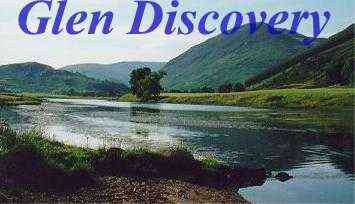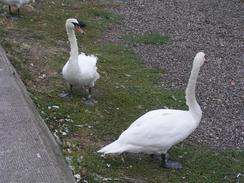
 |
PÓdraig mac Iain mhic Labhruidh |
|
I am known to officialdom as Peter John Lawrie, which in Scots Gaelic would be PÓdraig Iain Labhruidh. Alternatively, PÓdraig mac Iain mhic Labhruidh, which means Peter (or Patrick), the son of John, of the kindred of Lawrie. This was a naming pattern widely used in Highland Scotland up to the 18th century. Lawrie is a diminutive of Lawrence. As I am currently learning to speak Gaelic, the language of my ancestors, through the online An c¨rsa Inntrigidh at Sabhal M˛r Ostaig I am able to introduce myself with a Gaelic name PÓdraig Iain Labhruidh. An Internet search for "Peter Lawrie" usually brings up pages upon pages about some guy who appears to enjoy knocking a ball about with a bent stick for some strange reason which is totally beyond me. Perhaps I should promote my website as Padraig Labhruidh in future! Despite the pretensions of Donald MacLaren of MacLaren, the chief of the modern Clan MacLaren, to "own" all Lawries, Lawrences and variants of the name, there were at least 11 medieval churches, 6 chapels and 2 hospices dedicated to St Lawrence around Scotland. It was common for foundlings and others to be named after the local parish saint. Our modern surnames Lawrence and Lawrie with all their variants have multiple origins, which has been confirmed by Y-DNA studies. MacLarens of Clann Labhruinn descend from a particular Lawrence who was Bishop of Argyll from 1264 until his death in 1299. The MacLarens are considered at greater length on this webpage - the Clans of Balquhidder. A webpage discussing the variants of Lawrie and my own descent is here [See below, on this page, for the various pre-Reformation dedications to St Lawrence.] Welcome to my occasional doodlings on Scottish Highland History, a subject which has interested me since my schooldays in the 1960s at Inverness Royal Academy. That might surprise the history teacher, Mr Cameron, who once belted me for not paying attention to his teaching! (It may have been a boring topic about the British Empire) Although I became diverted into taking a Science degree at St Andrews University followed by a career in IT, my interest in History reawakened in the early 1980s when I looked into my ancestry in the Highlands and (whisper it) the North of England. From copious notes scribbled in folders I began to create webpages as the internet came into being in the 1990s. Following redundancy from a manufacturing company in 2003, I briefly entertained the idea of becoming a Tour Guide and set up a company named Glen Discovery. However, I soon realised that I could earn more in IT and settled on running Glen Discovery Ltd as my own small IT support company. Over the years I have concentrated on articles relating to the history and genealogy of Clan Gregor; Sutherland; and a third section of miscellaneous jottings on aspects of Scottish History with these links. Articles on Sutherland ..... Articles on the history of Clan Gregor ...... Miscellaneous articles on aspects of Scottish History |
 |
For the development of the kilt click here for my article on the clothing of our ancestors. See also the article on Ancient Highland Dress by the Scottish Tartans authority. How did Scottish Highland dress transform from an illegal garb to one worn by kings? "That from and after the First Day of August 1747, no man or boy within that part of Great Britain called Scotland, other than such as shall be employed as Officers and Soldiers of His Majesty's Forces, shall on any pretext whatsoever, wear or put on the clothes, commonly called Highland clothes (that is to say) the Plaid, Philabeg, or little kilt, Trowes, Shoulder-Belts, or any part whatever of what peculiarly belongs to the Highland Garb; and that no tartan or party-coloured plaid or stuff shall be used for Great coats or upper coats, and if any such person shall presume after the first said day of August, to wear or put on the aforesaid garments or any part of them, every person so offending.... shall be liable to be transported to any of His Majesty's plantations beyond the seas, there to remain for the space of seven years." See my paper on the Dress Act for further detail here |
 |
 |
The legislation against Highland dress was repealed in 1782. In 1822, Sir Walter Scott stage-managed the visit of George IV to Edinburgh, in which the king himself was persuaded to wear a kilt. (George IV is illustrated on the right.) From then on every family in Scotland had to have its own clan tartan made by the woollen weavers of Lowland Stirlingshire and Clackmannan. Most modern tartans (with a few exceptions) date from this time or after. The process is by no means complete and it is common today for companies and institutions in Scotland to have their own tartan. Although I am descended from a number of Highland clans, my male line 'Lawrie' ancestors lived in Banff in the 17th century. One of them, James Lawrie, was taken "in arms with the rebels" of the Jacobite army, defeated at Culloden in 1746. Other Lawrie families in the 16th to 18th centuries were found in the Lothians, in Lanarkshire and in Dumfries (the famous Annie Laurie of Maxwelton). One of my distant cousins has designed and registered a 'Lawrie' tartan and I have used it as a background with his kind permission. |
 |
 |
The outfit on the right is from a portrait in the possession of the current clan Chief, Sir Malcolm MacGregor, Bart. This was worn by his ancestor Sir Evan MacGregor Murray, 2nd Baronet as commander of the MacGregor Guard of Honour during the King’s visit to Edinburgh in 1822. It should be remembered that from 1603 to 1775 as a result of the proscription of the Clan Gregor, it was illegal to be even called MacGregor, or for a MacGregor to possess a weapon, never mind parading in front of the monarch in a costume which would have earned exemplary punishment little more than a generation earlier. On the left is an outfit made for an unknown gentleman to be worn during the 1822 festivities. |
 |
 |
As vice-chairman of The Clan Gregor Society, I usually wear a MacGregor kilt. The jacket is a replica of an 17th century slashed doublet, while the sporran is similar to 18th century designs. My MacGregor connection is through my paternal grandmother Laurie Helen MacGregor. Investigating gran's MacGregor origins has led to many years of genealogical research, which never seems to come to an end! The tartan on the left is a variant with a more muted red. |
 |
| Dedications to St Lawrence in Scotland. From: Ancient church dedications in Scotland, McKinlay, James Murray; Edinburgh, D. Douglas, 1910-14. https://catalog.hathitrust.org/Record/001407155 Churches: Lundie; Edzell; Rossieclerah; Portmoak; Forres; Fordyce (Banffshire); Burray (Orkney); Rayne (Aberdeenshire); Slamannan (Stirling); Morebattle (Roxburgh); Bondington (Berwickshire) Chapels: Bankhead, (Cunningham, Ayrshire); Overkelwood (Dumfries); Fairgirth (Kirkcudbright); Perth; Stonehouse (Lanarkshire); Beaufort Castle (Inverness-shire). Hospices: Peebles; Haddington. |
||
 |
Curious swans at Broughty Ferry, wondering where the Pelican came from. - But not nearly as curious as the flock of twitchers following its every move! |

|